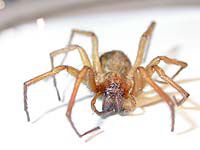| Hobo spider bites pose potentially serious injury risks to humans. No cases have be documented in the local area, but hobo spiders have been confirmed in Sanpete and San Juan counties. Residents are encouraged to capture and take suspected hobo spiders to the USU Extension office at the county courthouse in Price. |
Spiders are an important part of the ecosystem. Spiders are generally beneficial in that they are predators of most insect pests.
As the weather turns cold, homes in Carbon County get invaded by insects and spiders.
Most spiders do not survive well indoors. However, spiders in the house are never fun.
The bite of most spiders causes nothing more than a slight skin irritation. A few spiders, however, can produce a serious reaction in people. These include the black widow, hobo and brown recluse spiders.
Most people can recognize and avoid the black widow and the brown recluse has not been documented in Utah.
A major concern that is spreading throughout Utah is the hobo spider.
The hobo spider was introduced into the United States through Seattle several years ago and has been spreading from Washington across the country.
There have been no documented cases of hobo spiders in Carbon County. But there have been some hobo spiders confirmed in Sanpete and San Juan counties.
Local residents should capture and bring suspected hobo spiders into the USU Extension office at the county courthouse for identification.
Hobo spiders can be found outdoors year-round. But the adults are most commonly found indoors from July through September, when males wander in search of female mates.
Females tend to stay in funnel-shaped webs in protected corners and behind furniture inside homes or buildings.
Most bites are inflicted by males from July through September.
The hobo spider bite has the potential to cause serious injury to humans. Symptoms vary with the spider’s life stage.
Bites from males in July to September usually result in lesions and systemic spread without serious illness.
Extensive injection of poison by males may result in more serious effects such as blood and organ damage.
Bites by females, usually in late October to December, tend to cause less injury – generally a well-defined reddened area with a white pinpoint blister.
Bites by immature hobo spiders occur rarely from November to May, but tend to be the most serious. Extensive lesions, severe systemic effects and blood disorders or internal organ damage may occur.
The definitive characteristic of the hobo that must be viewed with a microscope include the number and position of teeth on the spider’s jaw.
The hobo resembles other members of the funnel-web spider family that are harmless or cause minor bite reactions.
For this reason, identification of suspected hobo spiders should be confirmed by an entomologist or trained person.
Extension offices and the Utah Plant Pest Diagnostic Lab on the USU campus provide spider identification assistance.
For information on sample submissions, residents with Internet access may visit http://extension.usu.edu/cooperative/uppdl.
A combination approach to spider control in the home is generally more effective than relying on a single method. Habitat modification, exclusion, trapping, avoidance of risk and chemical control are effective control options.
�Habitat modification includes cleaning frequently behind furniture, along baseboards, in corners behind doors and in other undisturbed areas.
Hobo spiders are more common in basements and on the first floor of the home. The spiders do not climb smooth surfaces and prefer to move downward.
Vacuum cleaner bags can be frozen to kill spiders before disposing.
Outdoor debris, including wood piles, should be removed and overgrown vegetation should be pruned away from foundations.
Large cracks or cavities should be filled with mortar or cement.
•Exclusion methods include installing effective under-door seals, repairing window screens and sealing all cracks that may allow spider entry.
•Spider traps may be purchased at many home supply stores. Traps may also be made from a cardboard paper towel tube and sticky adhesive. Traps provide monitoring information and control.
�Avoiding risk involves awareness and elimination of situations where hobo spiders are likely to be encountered.
Indoor sites such as the basement floor, furniture and bedding that touch the floor and undisturbed areas with funnel webs are likely places to encounter the spiders.
When working outdoors, protective clothing should be worn when in potential habitats such as wood piles, tall vegetation and storage areas.
•Chemical insecticides are generally not effective without the use of other control measures.
Insecticide formulations that are applied dry and form a suspension rather than a solution are more effective against spiders since the active ingredient remains on the surface.
Recommended insecticides labeled for indoor spider control include four types of formulation. Types include dusts like bendiocarb, boric acid, cyfluthrin, diatomaceous earth and pyrethrins; wettable powders like cyfluthrin, cyhalothrin, cypermethrin and esfenvalerate; flowable concentrates like bifenthrin and carbaryl; and microencapsulated suspensions like cyfluthrin and pyrethrins.
Most of the products are restricted to use by commercial applicators.
Local residents should always carefully read and follow the label before using.
The hobo is not aggressive and most bites occur when the spider is trapped in clothing or bedding.
Understanding the spider’s behavior and habitat preferences is helpful in preventing bites.
For more recognition and control information, residents may review see the hobo spider fact sheet number 86 by Alan Roe on the USU Extension website at http://extension.usu.edu/insect/fs/hobospid.htm.

